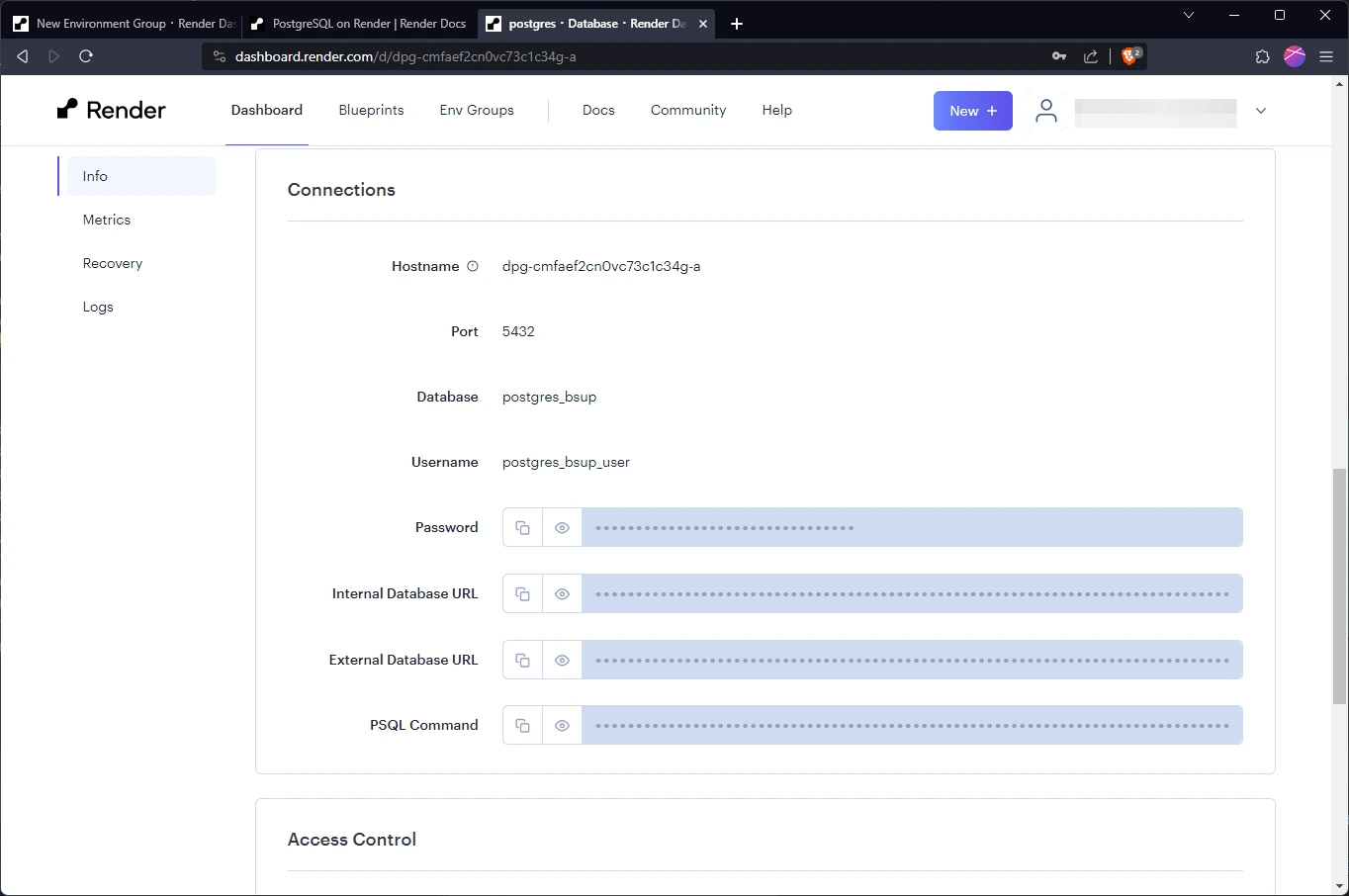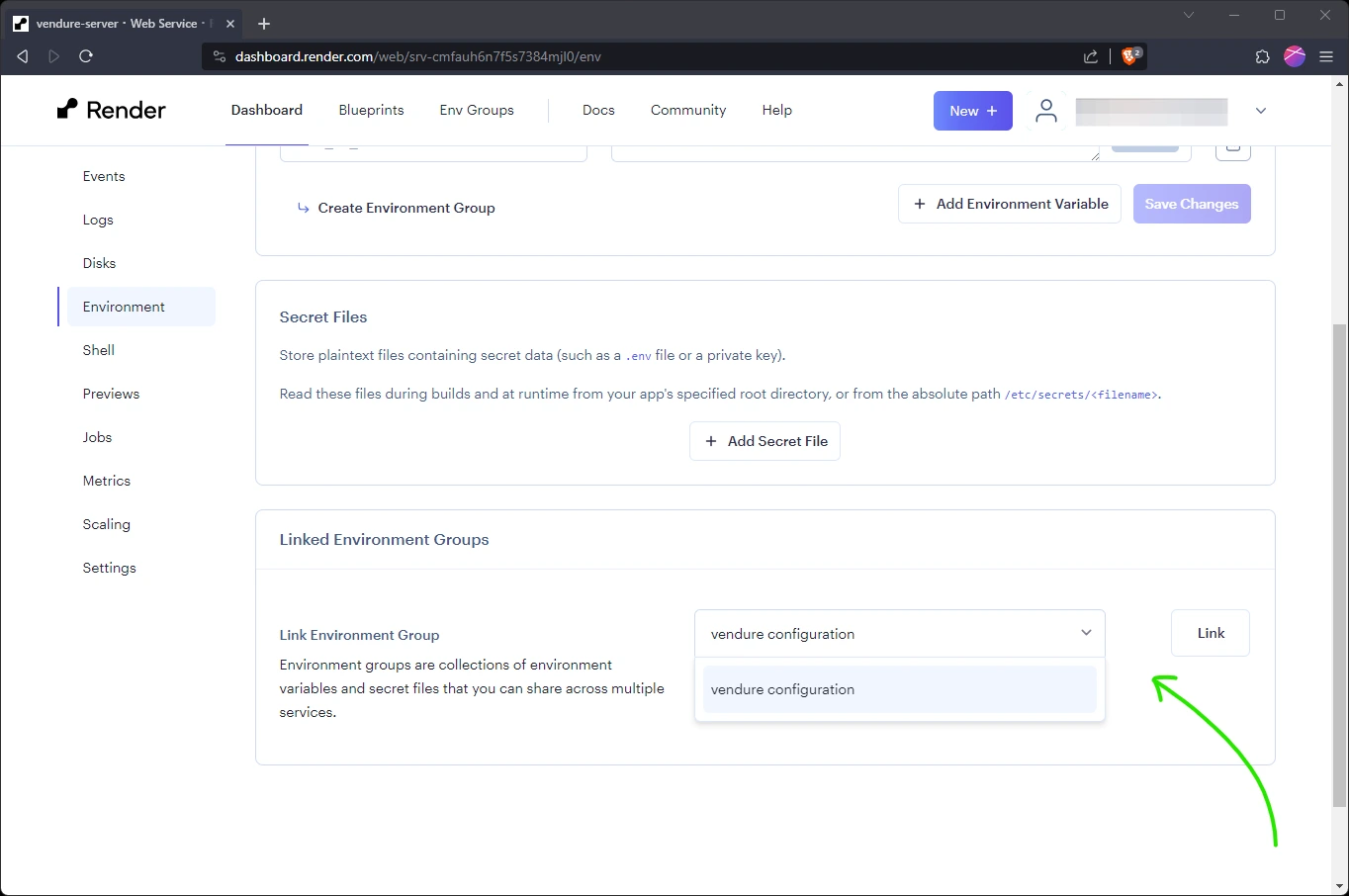Deploying to Render

Render is a managed hosting platform which allows you to deploy and scale your Vendure server and infrastructure with ease.
The configuration in this guide will cost from around $12 per month to run.
Prerequisites
First of all you'll need to create a new Render account if you don't already have one.
For this guide you'll need to have your Vendure project in a git repo on either GitHub or GitLab.
If you'd like to quickly get started with a ready-made Vendure project which includes sample data, you can use our Vendure one-click-deploy repo, which means you won't have to set up your own git repo.
Configuration
Port
Render defines the port via the PORT environment variable and defaults to 10000, so make sure your Vendure Config uses this variable:
import { VendureConfig } from '@vendure/core';
export const config: VendureConfig = {
apiOptions: {
port: +(process.env.PORT || 3000),
// ...
},
// ...
};
Database connection
The following is already pre-configured if you are using the one-click-deploy repo.
Make sure your DB connection options uses the following environment variables:
import { VendureConfig } from '@vendure/core';
export const config: VendureConfig = {
// ...
dbConnectionOptions: {
// ...
database: process.env.DB_NAME,
host: process.env.DB_HOST,
port: +process.env.DB_PORT,
username: process.env.DB_USERNAME,
password: process.env.DB_PASSWORD,
},
};
Asset storage
The following is already pre-configured if you are using the one-click-deploy repo.
In this guide we will use the AssetServerPlugin's default local disk storage strategy. Make sure you use the
ASSET_UPLOAD_DIR environment variable to set the path to the directory where the uploaded assets will be stored.
import { VendureConfig } from '@vendure/core';
import { AssetServerPlugin } from '@vendure/asset-server-plugin';
export const config: VendureConfig = {
// ...
plugins: [
AssetServerPlugin.init({
route: 'assets',
assetUploadDir: process.env.ASSET_UPLOAD_DIR || path.join(__dirname, '../static/assets'),
}),
],
// ...
};
Create a database
From the Render dashboard, click the "New" button and select "PostgreSQL" from the list of services:

Give the database a name (e.g. "postgres"), select a region close to you, select an appropriate plan and click "Create Database".
Create the Vendure server
Click the "New" button again and select "Web Service" from the list of services. Choose the "Build and deploy from a Git repository" option.
In the next step you will be prompted to connect to either GitHub or GitLab. Select the appropriate option and follow the instructions to connect your account and grant access to the repository containing your Vendure project.
If you are using the one-click-deploy repo, you should instead use the "Public Git repository" option and enter the URL of the repo:
https://github.com/vendure-ecommerce/one-click-deploy
Configure the server service
In the next step you will configure the server:
- Name: "vendure-server"
- Region: Select a region close to you
- Branch: Select the branch you want to deploy, usually "main" or "master"
- Runtime: If you have a Dockerfile then it should be auto-detected. If not you should select "Node" and enter the appropriate build and start commands. For a
typical Vendure project these would be:
- Build Command:
yarn; yarn buildornpm install; npm run build - Start Command:
node ./dist/index.js
- Build Command:
- Instance Type: Select the appropriate instance type. Since we want to use a persistent volume to store our assets, we need to use at least the "Starter" instance type or higher.
Click the "Advanced" button to expand the advanced options:
- Click "Add Disk" to set up a persistent volume for the assets and use the following settings:
- Name: "vendure-assets"
- Mount Path:
/vendure-assets - Size: As appropriate. For testing purposes you can use the smallest size (1GB)
- Health Check Path:
/health - Docker Command:
node ./dist/index.js(if you are not using a Dockerfile this option will not be available)
Click "Create Web Service" to create the service.
If you have not already set up payment, you will be prompted to enter credit card details at this point.
Configure environment variables
Next we need to set up the environment variables which will be used by both the server and worker. Click the "Env Groups" tab and then click the "New Environment Group" button.
Name the group "vendure configuration" and add the following variables. The database variables can be found by navigating to the database service, clicking the "Info" tab and scrolling to the "Connections" section:

DB_NAME=<database "Database">
DB_USERNAME=<database "Username">
DB_PASSWORD=<database "Password">
DB_HOST=<database "Hostname">
DB_PORT=<database "Port">
ASSET_UPLOAD_DIR=/vendure-assets
COOKIE_SECRET=<add some random characters>
SUPERADMIN_USERNAME=superadmin
SUPERADMIN_PASSWORD=<create some strong password>
Once the correct values have been entered, click "Create Environment Group".
Next, click the "vendure-server" service and go to the "Environment" tab to link the environment group to the service:

Create the Vendure worker
Finally, we need to define the worker process which will run the background tasks. Click the "New" button and select "Background Worker".
Select the same git repo as before, and in the next step configure the worker:
- Name: "vendure-worker"
- Region: Same as the server
- Branch: Select the branch you want to deploy, usually "main" or "master"
- Runtime: If you have a Dockerfile then it should be auto-detected. If not you should select "Node" and enter the appropriate build and start commands. For a
typical Vendure project these would be:
- Build Command:
yarn; yarn buildornpm install; npm run build - Start Command:
node ./dist/index-worker.js
- Build Command:
- Instance Type: Select the appropriate instance type. The Starter size is fine to get started.
Click the "Advanced" button to expand the advanced options:
- Docker Command:
node ./dist/index-worker.js(if you are not using a Dockerfile this option will not be available)
Click "Create Background Worker" to create the worker.
Finally, click the "Environment" tab and link the "vendure configuration" environment group to the worker.
Test your Vendure server
Navigate back to the dashboard, click the "vendure-server" service, and you should see a link to the temporary domain:

Click the link and append /admin to the URL to open the Admin UI. Log in with the username and password you set in the
environment variables.
Next Steps
This setup gives you a basic Vendure server to get started with. When moving to a more production-ready setup, you'll want to consider the following:
- Use MinIO for asset storage. This is a more robust and scalable solution than the local disk storage used here.
- Use Redis to power the job queue and session cache. This is not only more performant, but will enable horizontal scaling of your server and worker instances.